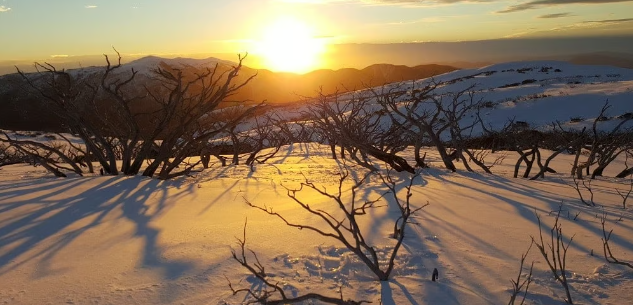
Everything You Need to Know About Snowy Mountain Backcountry Skiing
As summer closes in Australia, the autumn leaves fall and our attention very excitedly turns to the slopes as the colder months begin to ramp up! With this excitement in mind, we can’t help but get a little bit giddy at the prospect of once again going boldly off the beaten track and into the ungroomed runs of backcountry skiing.
Such is the nature of backcountry skiing, we understand it may not be for everyone, but we also understand that some may not truly know what backcountry skiing is – or how to properly prepare. In this guide, we aim to educate those who have no idea about the difference between skiing and backcountry skiing, and to get those who are aware, to get excited for the winter months!
So what is backcountry skiing?
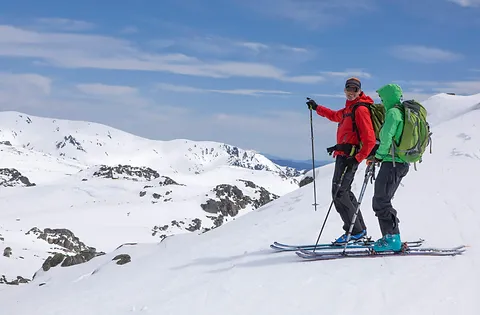
Image source: Snowy Mountains Backcountry
Backcountry skiing is for those who wish to venture away from the standard runs and lifts of a ski resort and head into the territory of ungroomed runs and peaks. It is not to say that backcountry skiing only involves ungroomed or “off-track” runs, there can still be a crossover into popular runs, but the primary focus of backcountry skiing is to head into territory that is unexplored or curated for the casual skier/boarder.
Backcountry skiing in Australia is best during the heart of winter, from July through to August, but this can be dependent on the snow season each year. In Australia, the snow season does often take some time to hit its stride, so ungroomed runs may be more patchy than snow-filled in the months of June. In contrast, the snow season can sometimes expand into early September if the snowfall has been cold and strong throughout August.
What type of back-country ski gear is required?
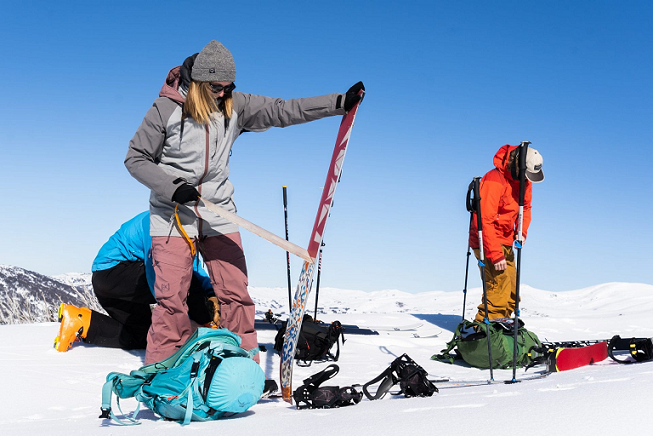
Image source: Snows Best
In order to correctly go backcountry skiing and skip all of the lift queues, one of the most important pieces of equipment you’ll need are climbing skins. These skins are absolutely necessary to essentially ski up the mountain and get yourself to the necessary peaks and runs that you wish to go to, off-track. These skins are exactly as they sound, they’re a skin you place on top of your skis that you remove once you have reached the peak. Many of these skins can be applied and then reapplied multiple times without wear.
We’d also recommend investing in some sturdy ski poles that will help get you up the mountain with force. When going off-track, it is highly recommended you carry a backpack with any necessary food and supplies, and a map of the mountain you’re on just in case you do get a little lost. In line with keeping safe, we also recommend wearing a sturdy helmet, backcountry skiing often involves weaving in and out of the small spaces between trees, so safety is paramount.
Where is the best place to go backcountry skiing in Australia?
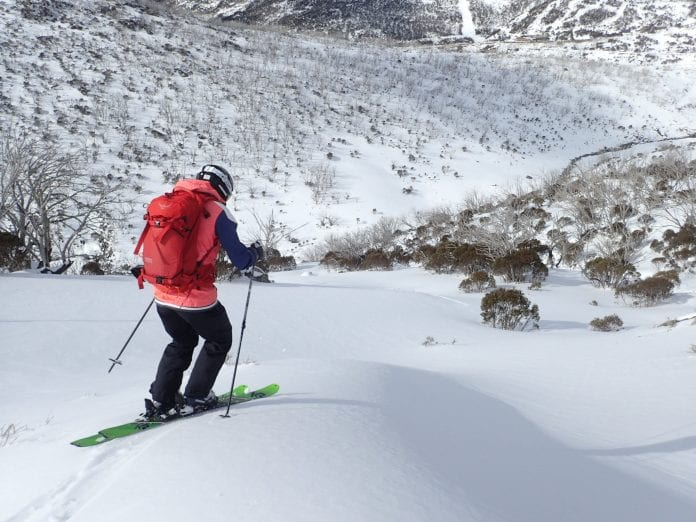
Image source: Snows Best
Backcountry skiing in Australia is all located on the eastern coast, more specifically the snowy mountains region of Australia. Snowy Mountains skiing is the best Australia offers with resorts like Perisher and Thredbo. Perisher is Australia’s most popular ski resort and is also the largest ski resort in the southern hemisphere. With this comes some of the most popular and spectacular ungroomed runs that are a backcountry skier’s paradise.
Perisher’s sprawling mountain range in the winter months allows for your ski touring to go anywhere you desire on-mountain. Perisher also offers a great atmosphere for young families to come and experience all that snowy mountain skiing provides. Ski Touring in Australia just got a whole lot better. With plenty of smaller runs for younger children, day activities, and lessons catered for youth and families, it is the perfect opportunity for you to take your family skiing and not miss out on what Perisher has to offer.
If you’re in the Victorian high country, there are also plenty of great mountains to backcountry ski in resorts like Mt Hotham and Falls Creek, but we do recommend making the journey further north into the snowy mountains.
Backcountry for beginners… AKA Slackcountry
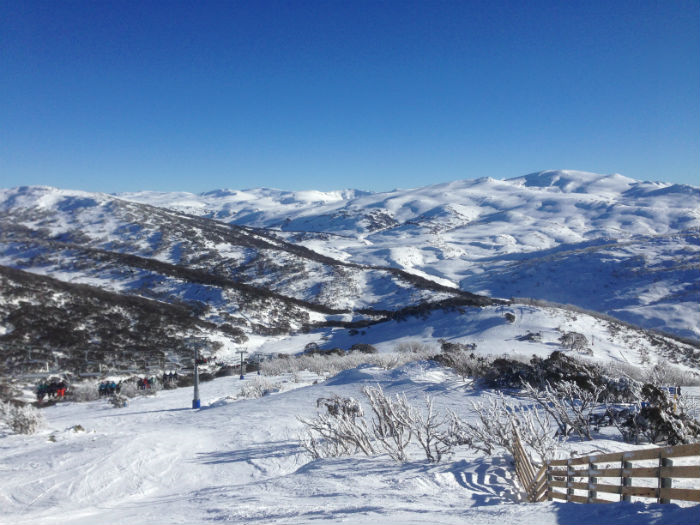
Image source: Snow Season Central
If heading into the unknown excites you, but perhaps you don’t have the right gear or aren’t too fond of forging your own path to get into backcountry territory – there is a popular alternative that is perfect for beginners. This alternative is known as ‘slackcountry’ skiing and is the process of remaining on a resort’s mountain range and accessing backcountry skiing spots via a resort lift. ‘Slackcountry’ skiing provides a much easier way of navigating the mountain and is great to learn and understand the more nuanced aspects of backcountry skiing, particularly when learning how to ski through ungroomed runs. It is a great way to dive in without the risk of heading too off-course or having to bring climbing skins.
Due to the lack of backcountry equipment, slackcountry skiing must reorientate you back to the resort or lift, so as to not get lost without proper equipment. Due to the sheer size of Perisher’s open-range resort, it is perfect for those looking to learn how to backcountry ski by first learning how to ski slackcountry. With 47 lifts that are fully operational in the thick of winter, it is a perfect opportunity to find a range of slackcountry runs that will more than whet the appetite of those looking to learn and go down ungroomed runs.
Best backcountry tours in NSW
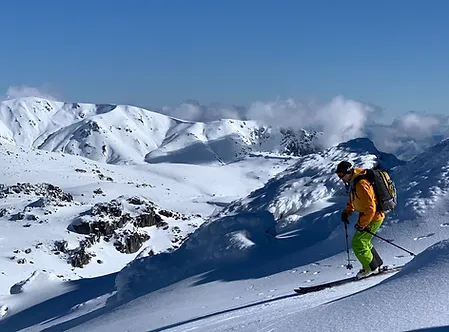
Image source: Snowy Mountains Backcountry
Some of the best ski touring Australia has to offer can be found in the snowy mountains, with backcountry tours located primarily out of Guthega Village out of the Guthega Mountain Center on Perisher. The team that runs these tours have over 25 years of experience and run an incredible set of tours that is perfect for those looking to expand their skills in backcountry skiing. These tours run all throughout the winter, but it is best to plan in advance and contact the team to let them know when you plan on going on a backcountry tour through Perisher.
Snow Mountains Backcountry Tours is also another great team that operates out of Thredbo resort and provides some of the best snowy mountain tours with plenty of years of experience in the Kosciusko region. They offer full and half-day tours and offer a great array of challenges along their backcountry tours.
How do I best prepare for my first backcountry trip??
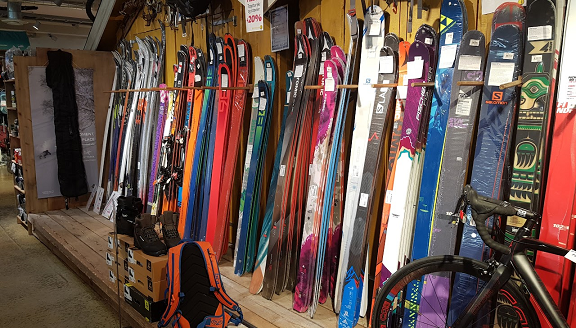
Image source: Backcountry Skiing
Safety always comes first when you are planning a backcountry trip. Make sure you have all the right equipment, that you’ve notified people that you’re travelling backcountry and that you have emergency equipment in the off-chance that you get lost. As previously mentioned, a helmet, map, and water are a must!
When planning your backcountry trip, make sure you map out some form of the path that you wish to take – going in blind can be quite dangerous and will get you lost very quickly. If you map out the type of run you want to take and follow a structured path, you’ll find the experience all the more enjoyable and worthwhile.
Whether it is your first time going backcountry skiing or you are a seasoned veteran, the best tip we can give is to take it slow. Enjoy the atmosphere that going on your own path provides, take in the surroundings, and don’t feel like you have to speed down an ungroomed run.
Backcountry skiing offers a unique experience, one that paves your own way forward and isn’t confined to the valleys and peaks of a normal, groomed run.
Planning your latest backcountry skiing trip this winter? Be sure to plan your stay at Eiger Chalet, with a wide range of activities and fine dining options, Eiger Chalet is the perfect place to rest for the night after a big day of backcountry skiing.

